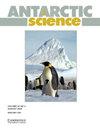南极洲乔治王岛上影响微节肢动物(蜱螨、线虫)α多样性的因素是什么?
IF 2
4区 地球科学
Q3 ENVIRONMENTAL SCIENCES
引用次数: 0
摘要
摘要极地地区的自然环境正在发生变化,冰川正在融化,微节肢动物正在演替。我们验证了生境条件在这种演替中起重要作用的假设,生境条件由植被覆盖的位置和特征决定。用于分析的材料是从南极洲乔治王岛的四个地点收集的:阿尔托斯基站、德梅保护区、厄瓜多尔共和国保护区和费拉兹南极站。各区共采集禾草、地衣、苔藓类30份,共记录小节肢动物标本310508份,鉴定中鞭毛目1种、甲虫目9种、弹虫目7种。统计分析结果表明,小节肢动物群落在不同的生境和不同的微生境中存在差异。草皮中报告的种类最多,而苔藓中记录的个体数量最多。各地区优势种均为南极隐蝽(299203只),以禾本科和藓类中数量最多。地衣的优势种为混合土藓(2485株)。此外,还发现了乔治王岛新种:甲虫亚纲的Flagrosuctobelba subcornigera、Liochthonius australis、腹状膜虫(Membranoppia ventrolaminata)和四足虫(Quadroppia monstruosa),以及Collembola纲的Archisotoma bruei。本文章由计算机程序翻译,如有差异,请以英文原文为准。
What factors affect the alpha diversity of microarthropods (Acari, Collembola) on King George Island (Antarctica)?
Abstract The natural environment in polar regions is being transformed, glaciers are melting and succession of microarthropods is being observed. We tested the hypothesis that habitat conditions, determined by the locality and character of the vegetation cover, play a significant role in such succession. The material for analysis was collected from four localities on King George Island in Antarctica: Arctowski Station, Demay Refuge, Republica del Ecuador Refuge and Comandante Ferraz Antarctic Station. From each locality, 30 samples (grasses, lichens, mosses) were collected and 310 508 microarthropod specimens were recorded, with 17 species (1 Mesostigmata, 9 Oribatida, 7 Collembola species) identified. Based on statistical analyses, it was shown that microarthropod communities differ both in individual localities and selected microhabitats. The greatest number of species was reported in the grass turf, while the greatest number of individuals was recorded in mosses. The dominant species at all the localities was Cryptopygus antarcticus antarcticus (299 203 individuals), which was found in greatest numbers in grasses and mosses. In turn, Tullbergia mixta (2485 individuals) was the dominant species of the lichens. Moreover, the following species, new to King George Island, were also identified: Flagrosuctobelba subcornigera , Liochthonius australis , Membranoppia ventrolaminata and Quadroppia monstruosa belonging to Oribatida as well as Archisotoma brucei belonging to Collembola.
求助全文
通过发布文献求助,成功后即可免费获取论文全文。
去求助
来源期刊

Antarctic Science
地学-地球科学综合
CiteScore
3.60
自引率
6.20%
发文量
42
审稿时长
3 months
期刊介绍:
Antarctic Science provides a truly international forum for the broad spread of studies that increasingly characterise scientific research in the Antarctic. Whilst emphasising interdisciplinary work, the journal publishes papers from environmental management to biodiversity, from volcanoes to icebergs, and from oceanography to the upper atmosphere. No other journal covers such a wide range of Antarctic scientific studies. The journal attracts papers from all countries currently undertaking Antarctic research. It publishes both review and data papers with no limits on length, two-page short notes on technical developments and recent discoveries, and book reviews. These, together with an editorial discussing broader aspects of science, provide a rich and varied mixture of items to interest researchers in all areas of science. There are no page charges, or charges for colour, to authors publishing in the Journal. One issue each year is normally devoted to a specific theme or papers from a major meeting.
 求助内容:
求助内容: 应助结果提醒方式:
应助结果提醒方式:


